Glossary of Terms
A B C D E F G H I J K L M N O P Q R S T U V W X Y Z
Select the first letter of the word you are seeking from the list above to jump to the appropriate section of the glossary or scroll down to it.
- A -
- Acheulean
 Tool Tradition
Tool Tradition
- the most well known stone tool making tradition of Homo erectus and early Archaic Homo sapiens. It first appeared about 1.6-1.4 million years ago in East Africa and eventually spread throughout Africa, Southern Europe, and South Asia. The most diagnostic Acheulean artifact is the hand ax.
- adaptive radiation
- the relatively rapid expansion and diversification of an evolving group of organisms as they adapt to new ecological niches. Adaptive radiation is the process by which one species evolves into two or more species. This occurs as a result of different populations becoming reproductively isolated from each other, usually by adapting to different environments.
- archaic Homo sapiens

- the variety of Homo sapiens that was intermediate between Homo erectus and modern humans. The earliest archaic Homo sapiens appeared before 200,000 years ago. The last were the Neandertals, who survived until nearly 30,000 years ago.
- artifact

- a thing that has been manufactured or intentionally modified for some use. Stone tools such as hand axes are examples of artifacts.
- australopithecines

- any species of the genus Australopithecus. They lived in East and South Africa from about 4.2 to 2.5 million years ago. The first species may have been Australopithecus anamensis (4.2-3.9 million years ago). They were followed by Australopithecus afarensis (3.9-3.0 million years ago) and finally by Australopithecus africanus (3.0-2.5 million years ago). Australopithecines, paranthropoids, and humans are the only known hominids.
- Australopithecus

Back to Top
- B -
- big
game hunting
- a specialized subsistence pattern based primarily on hunting large animals, especially herbivorous herding mammals such as horses, reindeer, bison, and elephants.
- biocultural
 evolution
evolution
- the pattern of human evolution beginning at least with Homo erectus in which the effects of natural selection are altered by cultural inventions. Culture can alter the direction of evolution by creating non-biological adaptations to environmental stresses (e.g., wearing insulating clothes on very cold days). This potentially reduces the need to evolve genetic responses to the stresses.
- bipedal

- a two-footed, upright form of locomotion typical of hominids. Human walking is an example of bipedalism.
Back to Top
- C -
- carnivorous

- eating only meat. Animals that have this sort of diet are carnivores. See herbivorous and omnivorous.
- core
tool

- a tool made from a relatively large block of rock rather than from the flakes that are removed from it by percussion flaking in the manufacturing process. Most hand axes are core tools.
- cranial capacity
-
- Back to Top
- D -
- developmental
adjustment
- a change in the normal growth patterns and development of an individual that occurs in childhood as a result of specific cultural practices or other environmental processes. The anatomical and physiological changes that result are mostly irreversible by adulthood. Example: stunted growth and mild mental retardation due to severe, prolonged undernourishment.
- E -
- ecological niches

- specific micro-habitats in nature to which populations or organisms adapt. They are usually seen in terms of being food getting opportunities in the environment.
- East Asian Chopping Tool Tradition
a stone tool making tradition of late Homo erectus in East Asia. It is most well known from the site of Zhoukoudian
near Beijing, China. Unlike the Acheulean Tradition that was in use elsewhere at the same time, stone hand axes apparently were not made or used.
- evolution

- genetic change in a population of organisms that occurs over time. The term is also frequently used to refer to the appearance of a new species. More specifically, it is change in the gene pool frequencies of a population from one generation to the next.
- F -
- femur

- either one of the upper leg bones. In the case of 4 legged animals, the femurs are in the rear legs.
- flake tool

- an artifact made from a flake knocked off of a larger rock usually by percussion flaking. Homo habilis and Homo erectus used flakes mostly as cutting and scraping tools. Flakes may be intentionally produced for these purposes or they may be waste flakes produced in the process of making a core tool.
Back to Top
- G -
- genera

the plural of genus
(the level of classification immediately above species in the Linnaean classification system).
- gracile

- graceful, slender, and delicate. This 17th century English term is used to describe the body characteristics (especially bones) of Australopithecus afarensis, Australopithecus africanus, and Homo habilis.
- H -
- hand
ax
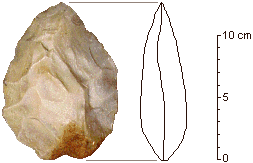
- a rock core or large flake that has been systematically worked by percussion flaking to an elongated oval shape with one pointed end and sharp edges on the sides. In profile, hand axes usually have a teardrop or leaf shape. Hand axes are diagnostic tools of the Acheulean Tool Tradition of Homo erectus after about 1.6-1.4 million years ago. They continued to be made and used by early archaic Homo sapiens. Very likely, they were multipurpose implements used for light chopping of wood, digging up roots and bulbs, butchering animals, and cracking bones.
- herbivorous

- eating only vegetable foods. Animals that have this sort of diet are herbivores or vegetarians.
- hominid

- any species of the primate family Hominidae. The australopithecines, paranthropoids, and humans are the only known hominids.
- Hominidae

- see hominid.
- Homo

- the genus in which all humans are classified.
- Homo erectus

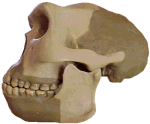
- the species of humans that followed Homo habilis and preceded Homo sapiens in our line of evolution. Homo erectus evolved in East Africa 1.8 million years ago. They were the first humans to expand their range into Asia and Europe. By 400,000 years ago, they were beginning a transitional evolutionary phase that would eventually lead to archaic Homo sapiens. See Homo ergaster and Homo heidelbergensis.
- Homo ergaster

- An early form of the species Homo erectus from East Africa. In an alternate interpretation, some researchers consider Homo ergaster to be the species that immediately preceded Homo erectus in our line of evolution. Homo ergaster fossils date 1.8-1.5 million years ago.
- Homo habilis

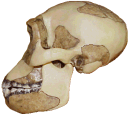
- the transitional species between the australopithecines and Homo erectus. Homo habilis may have first appeared by 2.5 million years ago and continued until about 1.6 million years ago. They lived in East and possibly South Africa.
- Homo heidelbergensis

- A late form of Homo erectus in Europe that lived from about 800,000 to 400,000 years ago (especially in Spain). In an alternate interpretation, some researchers consider Homo heidelbergensis to be a separate species from Homo erectus. Homo heidelbergensis may have been the ancestor of the Neandertals.
- Homo rudolfensis

- An early form of the species Homo habilis. In an alternate interpretation, some researchers consider Homo rudolfensis to be the species that immediately preceded Homo habilis in our line of evolution. Homo rudolfensis fossils date 2.4-1.9 million years ago.
- Homo sapiens

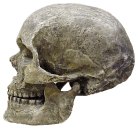
- Our species of humans. Homo sapiens evolved from Homo erectus over several hundred thousand years beginning about 400,000 years ago. The first modern Homo sapiens evolved from archaic Homo sapiens by about 100,000 years ago in Africa and/or the Middle East.
- human
- a member of the genus Homo.
-
- Back to Top
- I -
Back to Top
- J -
Back to Top
- K -
Back to Top
- L -
- Lake Turkana
 Boy
Boy
- a nearly complete Homo erectus skeleton of a 12 year old boy found by Richard Leakey's team on the western side of Lake Turkana , Kenya at the Nariokotome site. Lake Turkana Boy dates to 1.6 million years ago.
- M -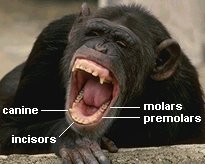
- molar
 teeth
teeth
- the comparatively large grinding teeth at the back of the mouth in mammals. In all hominids, apes, and Old World monkeys, there are normally 3 molars in each quadrant of the mouth.
- N -
- natural selection
- an evolutionary mechanism that occurs when some individuals of a population are better able to adapt to their environment and, subsequently, produce more offspring. Nature, in effect, selects which members of a population are fit to survive long enough to reproduce. Differential productive success between individuals is the key. Those who produce more offspring have a greater influence on the gene frequencies of the next generation. This mechanism of evolutionary change was first articulated by Charles Darwin.
- Neandertals

- The late archaic Homo sapiens population of Europe and parts of southwestern Asia. They first appeared about 130,000 years ago and continued until about 30,000 years ago. There is controversy over whether Neandertals are within our species or a separate but closely related one. It they are a variety of our species, they are Homo sapiens neanderthalensis. If they are a separate species, they are Homo neanderthalensis.
Back to Top
- O -
- Oldowan
 Tool
Tradition
Tool
Tradition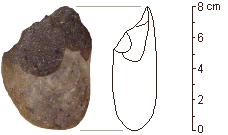
- the earliest stone tool making tradition. The first Oldowan artifacts were made in East Africa about 2.5 million years ago presumably by Homo habilis and continued to be made by early Homo erectus until about 1.5 million years ago. They consisted of simple core (shown below) and flake tools only slightly modified from their natural state by percussion flaking.
- omnivorous

- the ability to live by eating both meat and vegetable foods. See carnivorous and herbivorous.
- Osteodontokeratic
 Tool Tradition
Tool Tradition
- hypothetical early human and possibly late australopithecine and/or paranthropoid tool making tradition based on the use of bones, teeth, and horns. This was proposed in the 1940's by Raymond Dart, but most paleoanthropologists reject it today.
Back to Top
- P -
- paranthropoids

- members of any species of the genus Paranthropus. They lived during the late Pliocene and early Pleistocene geological Epochs in Africa (i.e., ca. 2.5-1.0 million years ago). Paranthropoids, australopithecines, and humans are the only known hominids.
- Peking
Man

- a common name given to the Homo erectus skeletal remains from the limestone cave site at Zhoukoudian
 , China. In the past, Peking Man was also
referred to as Sinanthropus pekinensis
, China. In the past, Peking Man was also
referred to as Sinanthropus pekinensis  (literally "Chinese man from Peking" or
Beijing).
(literally "Chinese man from Peking" or
Beijing). - pelvis

- the bones of the hip region. The pelvis is also referred to as the "pelvic girdle."
- percussion flaking
- a tool making technique in which a glass-like rock (e.g., obsidian, flint, chert, and basalt) that will potentially be an artifact is struck with a heavy glancing blow from another dense rock (i.e., a hammerstone) in order to cause a flake to be removed. An artifact can be shaped by carefully and systematically directing the percussion blows with the hammerstone. Percussion flaking works when a sufficiently large shock wave is directed into the target rock so that its elastic limit of the material is exceeded. This causes one or more flakes to be broken off.
- a common name given to the Homo erectus skeletal remains from the limestone cave site at Zhoukoudian
- Pithecanthropus
erectus

- the original name given by Eugene Dubois to the Homo erectus skeletal remains from Java. Literally, Pithecanthropus erectus means "ape-man who stands erect." This scientific designation is no longer in use.

- the original name given by Eugene Dubois to the Homo erectus skeletal remains from Java. Literally, Pithecanthropus erectus means "ape-man who stands erect." This scientific designation is no longer in use.
- premolar
 teeth
(bicuspids
teeth
(bicuspids  )
)
- Back to Top
- Q -
Back to Top
- R -
Back to Top
- S -
- Sinanthropus
pekinensis

- the original name given to the Homo erectus skeletal remains from the limestone cave site at Zhoukoudian
 , China. Sinanthropus
pekinensis literally means "Chinese man from Peking" or
Beijing.
, China. Sinanthropus
pekinensis literally means "Chinese man from Peking" or
Beijing. - subsistence pattern
- referring to sources of food and the way they are obtained (e.g., scavenging and hunting). "Subsistence base" and "subsistence strategy" also are used to mean essentially the same thing as subsistence pattern.
- subtropical
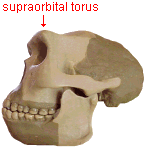 supraorbital tori
supraorbital tori  (singular: supraorbital
torus)
(singular: supraorbital
torus)
- prominent projecting bony bars or brow ridges above the eyes. This trait was characteristic of Homo erectus and some other early humans.
- the original name given to the Homo erectus skeletal remains from the limestone cave site at Zhoukoudian
-
- Back to Top
- T -
- temperate
- referring to climatic regions in between subtropical and subarctic zones. Temperate areas usually have winter snow and are too cold to grow oranges and avocados.
- tropical
- referring to the warmest climatic regions. They are usually found within 20°-30° latitude from the Equator. All human evolution until relatively late Homo erectus occurred in the tropics, especially in Africa. See subtropical and temperate.
Back to Top
- U -
Back to Top
- V -
Back to Top
- W -
Back to Top
- X -
Back to Top
- Y -
Back to Top
- Z -
Back to Top
This page was last
updated on Monday,
March 03,
2003.
Copyright ©
1999-2002 by Dennis O'Neil.
All rights reserved.
Illustration
credits